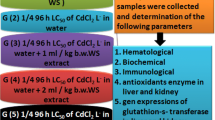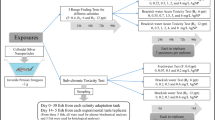Abstract
Wastewater from codfish (Gadus morhua L.) salting represents an environmental concern and a cost for processors which must address the disposal. Amino acids-enriched liquid salts (NaCl) were recovered from that effluent and were assessed for the antioxidant and anti-hypertensive activity, and for cytotoxicity to evaluate the possibility to be considered as a functional ingredient. Two samples were evaluated: a hypertonic salt at 15 g/L NaCl and 3 g/L amino acids, and an isotonic salt at 9 g/L NaCl and 1.8 g/L amino acids, obtained by diluting the former. Both samples showed moderate antioxidant activity; the values obtained for each assay depended on the mechanism of radical inhibition as well as on amino acids and NaCl concentration. No pro-oxidant effects on DNA were observed. Both salts demonstrated a significant anti-hypertensive activity with IC50 11 µg/mL for the hypertonic and 7.4 µg/mL for the isotonic sample. For the isotonic salt no cytotoxic effects on intestinal cells were noticed over 180 min, and on hepatic cells up to 70 min. The biological activity showed by the amino acids-enriched salt could prompt the application as a functional ingredient and drive the valorisation of the codfish salting wastewater.






Similar content being viewed by others
References
Somogyi, A., Rosta, K., Pusztai, P., Tulassay, Z., Nagy, G.: Antioxidant measurements. Physiol. Meas. 28, 41–55 (2007)
Stadtman, E.: Role of antioxidant species in aging. Curr. Med. Chem. 11, 1105–1112 (2004)
Guimarães, C.M., Gião, M.S., Martinez, S.S., Pintado, A.I., Pintado, E.M., Bento, L.S., Malcata, F.X.: Antioxidant activity of sugar molasses, including protective effect against oxidative damage. Food Chem. Toxicol. 72, 39–43 (2007)
Ohishima, H., Sawa, T., Akraike, T.: 8-Nitroguanidine, a product of nitrative DNA damage caused by reactive oxygen species: formation, occurrence, and implication of inflammation and carcinogenesis. Antioxid. Redox Signal. 8, 1033–1045 (2006)
Barzilay, A., Yamamoto, K.: DNA damage response to oxidative stress. DNA Repair (AMST) 3, 1109–1115 (2004)
Sohal, R.S.: Role of oxidative stress and proteins oxidation in the aging process. Free Radical Biol. Med. 33, 37–44 (2002)
Atmaca, G.: Antioxidant effect of sulfur-containing amino acids. Yonsei Med. J. 45, 776–788 (2004)
Wu, H.C., Shiau, C.Y., Chen, H.M., Chiou, T.K.: Antioxidant activity of carnosine, anserine, some free amino acids and their combination. J. Food Drug Anal. 11, 148–153 (2003)
Lawler, J.M., Barnes, W.S., Wu, G., Song, W., Demaree, S.: Direct antioxidant properties of creatine. Biochem. Biophys. Res. Commun. 290, 47–52 (2002)
Oudit, G.Y., Trivieri, M.G., Khaper, N., Husain, T., Wilson, G.J., Liu, P., Sole, M.J., Backx, P.H.: Taurine supplementation reduces oxidative stress and improves cardiovascular function in an iron-overload murine model. Circulation 109, 1877–1885 (2004)
Meucci, E., Mele, M.C.: Amino acids and plasma antioxidant capacity. Amino Acids 12, 373–377 (1997)
Myliutina, N.P., Ananyan, A.A., Shchugalei, V.S.: Antiradical and antioxidative effects of arginine and its influence on lipid peroxidation activity during hypoxia. Bull. Exp. Biol. Med. 110, 1198–1200 (1991)
Yu, X., Zhao, M., Hu, J., Zeng, S., Bai, X.: Correspondence analysis of antioxidant activity and UV–Vis absorbance of Maillard reaction products as related to reactants. LWT Food Sci. Technol. 46, 1–9 (2012)
Vasdev, S., Stuckless, J.: Antihypertensive effects of dietary protein and its mechanism. Int. J. Angiol. 19, 7–20 (2010)
Elliott, P., Stamler, J., Dyer, A.R., Appel, L., Dennis, B., Kestellot, H., Ueshima, H., Okayama, A., Chan, Q., Garside, D.B., Zhou, B.: Association between protein intake and blood pressure: the INTERMAP study. Arch. Intern. Med. 166, 79–87 (2006)
Stamler, J., Elliott, P., Kesteloot, H., Nichols, R., Claeys, G., Dyer, A.R., Stamler, R.: Inverse relation of dietary protein markers with blood pressure. Findings for 10,020 men and women in the INTERSALT study. Circulation 94, 1629–1634 (1996)
Ferraro, V., Cruz, B.I., Ferreira Jorge, R., Castro, M.L.P., Pintado, E.M.: Recovery of free amino acids and muscle proteins from codfish (Gadus murhua L.) salting wastewater. J. Chem. Technol. Biotechnol. 89, 671–681 (2014)
Ferraro, V., Cruz, B.I., Ferreira Jorge, R., Pintado, E.M., Castro, M.L.P.: Solvent extraction of sodium chloride from codfish (Gadus morhua L.) salting processing wastewater. Desalination 287, 42 (2011)
Benzie, I.F.F., Strain, J.J.: The ferric reducing ability of plasma (FRAP) as a measure of “Antioxidant Power”: the FRAP assay. Anal. Biochem. 239, 70 (1996)
Brand-Williams, W., Cuvelier, M.E., Berset, C.: Use of a free radical method to evaluate antioxidant activity. LWT Food Sci. Technol. 28, 11 (1995)
Ou, B., Hampsch-Woodill, M., Prior, R.L.: Development and validation of an improved oxygen radical oxygen assay using fluorescein as the fluorescent probe. J. Agric. Food Chem. 49, 4619–4626 (2001)
Dávalos, A., Gómez-Cordovés, C., Bartolomé, B.: Extending applicability of the oxygen radical absorbance capacity (ORAC-Fluorescein) assay. J. Agric. Food Chem. 52, 48 (2004)
Schwager, S.L., Carmona, A.K., Sturrock, E.D.: A high-throughput fluorometric assay for angiotensin I-converting enzyme. Nat. Protoc. 1, 1961–1964 (2006)
Berridge, M.V., Tan, A.S., McCoy, K.D., Wang, R.: The biochemical and cellular basis of cell proliferation assays that use tetrazolium salts. Biochemica 4, 14–19 (1996)
Sochor, J., Ryvolova, M., Krystofova, O., Salas, P., Hubalek, J., Adam, V., Trnkova, L., Havel, L., Beklova, M., Zehnalek, J., Provaznik, I., Kizek, R.: Fully automated spectrometric protocols for determination of antioxidant activity: advantages and disadvantages. Molecules 15, 8618–8640 (2010)
Frenkel, E.N., Merkel, A.S.: The problem of using one-dimensional method to evaluate multifunctional food and biological antioxidants. J. Sci. Food Agric. 80, 1925–1940 (2000)
Mishra, M., Mishra, P.K., Kumar, U., Prakash, V.: NaCl phytotoxicity induces oxidative stress and response on antioxidant system in Cicer arietinum L. CV. Abrodhi. Bot. Res. Int. 2, 74–82 (2009)
Ketonen, J., Marvaala, E.: Effects of dietary sodium on reactive oxygen species formation and endothelial dysfunction in low-density lipoprotein receptor-deficiency mice on high-fat diet. Heart Vessels 23, 420–429 (2008)
Zulueta, A., Esteve, M.J., Frígola, A.: ORAC and TEAC assay comparison to measure the antioxidant capacity of food products. Food Chem. 114, 310–316 (2009)
Huang, D., Ou, B., Prior, R.L.: The chemistry behind antioxidant capacity assays. J. Agric. Food Chem. 53, 1841–1856 (2005)
Dmitrieva, N.I., Burg, M.B., Ferraris, J.D.: DNA damage and osmotic regulation in the kidney. Am. J. Physiol. Renal Physiol. 289, 2–7 (2005)
Dmitrieva, N.I., Burg, M.B.: Osmotic stress and DNA damage. Meth. Enzymol. 428, 241–252 (2007)
Anastassopoulou, J.: Metal-DNA interactions. J. Mol. Struct. 651–653, 19–26 (2003)
Schlick, T., Li, B., Olson, W.K.: The influence of salt and on the structure and energetic of supercoiled DNA. Biophys. J. 67, 2146–2166 (1994)
Messina, S., Dawson Jr, R.: Attenuation of oxidative damage to DNA by taurine and taurine analogs. In: Della Corte, G. (ed.) Taurine 4: taurine and excitable tissues, pp. 355–367. Plenum Press, New York (2002)
Eppler, B., Dawson Jr, R.: Cytoprotective role of taurine in a renal epithelial cell culture model. Biochem. Pharmacol. 63, 1051–1060 (2002)
Obrosova, I.G., Fathallal, L., Stevens, M.J.: Taurine counteracts oxidative stress and nerve factor deficit in early experimental diabetic neuropathy. Exp. Neurol. 172, 211–219 (2001)
Hwang, D.F., Hour, J.L., Cheng, H.M.: Effects of taurine on toxicity of oxidized fish oil in rats. Food Chem. Toxicol. 38, 585–591 (2000)
Seneviratne, C.K., Khaper, N., Singal, P.K.: Effects of methionine on endogenous antioxidants in the heart. Am. J. Physiol. 227, 2124–2129 (1999)
McKenna, M.J., Morton, J., Selig, S.E., Snow, R.J.: Creatine supplementation increases muscle total creatine but not maximal intermittence exercise performance. J. Appl. Physiol. 87, 2244–2252 (1999)
Reid, M.B.: Redox modulation of skeletal muscle contraction: what we know and what we don’t. J. Appl. Physiol. 90, 724–731 (2001)
Morguerza, B., Ramos, M., Sánchez, E., Manso, M.A., Miguel, M., Aleixandre, A., Delgado, M.A., Recio, I.: Antihypertensive activity of milk fermented by Enterococcus faecalis strain isolated from raw milk. Int. Dairy J. 16, 61–69 (2006)
Tsai, H., Deng, H., Tsai, S., Hsu, Y.: Bioactivity comparison of extracts from various parts of common and tartary buckwheats: evaluation of the antioxidant- and angiotensin-converting enzyme inhibitory activities. Chem. Cent. J. 6, 78–82 (2012)
Vasdev, S., Singal, P., Gill, V.: The antihypertensive effect of cysteine. Int. J. Angiol. 18, 7–21 (2009)
Higashi, Y., Oshima, T., Ono, N., Hiraga, H., Yoshimura, M., Watanabe, M., Matsuura, H., Kambe, M., Kajiyama, G.: Intravenous administration of l-arginine inhibits angiotensin-converting enzyme in humans. J. Clin. Endocrinol. Metab. 80, 2198–2202 (1995)
Militante, J.D., Lombardini, J.B.: Treatment of hypertension with oral taurine: experimental and clinical studies. Amino Acids 23, 381–393 (2002)
Fregly, M.J., Sumners, C., Cade, J.R.: Effect of chronic dietary treatment with l-tryptophan on the maintenance of hypertension in spontaneously hypertensive rats. Can. J. Physiol. Pharmacol. 67, 656–662 (1989)
Ferraro, V., Cruz, B.I., Ferreira Jorge, R., Castro, M.L.P., Pintado, E.M.: In-vitro intestinal absorption of free amino acids extracted from codfish salting (Gadus murhua L.) wastewater. Int. J. Food Sci. Technol. 49, 27–33 (2014)
Martín-Venega, R., Rodríguesz-Laguna, M.J., Mercier, Y., Geraert, P.A., Ferrer, R.: Effect of pH on l- and d-methionine uptake across the apical membrane of Caco-2 cells. Am. J. Physiol. Cell Physiol. 269, 632 (2009)
Acknowledgments
Author Vincenza Ferraro thanks Marie Curie Actions (European Research Area) for a Doctoral Grant (Ref. InSolEx-RTN under FP6). This work was partially supported by National Founds from FCT – Fundação para a Ciência e Tecnologia, through the project PEst-OE/EQB/LA0016/2013.
Author information
Authors and Affiliations
Corresponding author
Ethics declarations
Conflict of interest
Authors declare no conflict of interest.
Rights and permissions
About this article
Cite this article
Ferraro, V., Sousa, S.C., Marques, C. et al. Antioxidant and Anti-hypertensive Activity, and Cytotoxicity of Amino Acids-Enriched Salt Recovered from Codfish (Gadus morhua L.) Salting Wastewater. Waste Biomass Valor 6, 1115–1124 (2015). https://doi.org/10.1007/s12649-015-9416-x
Received:
Accepted:
Published:
Issue Date:
DOI: https://doi.org/10.1007/s12649-015-9416-x




